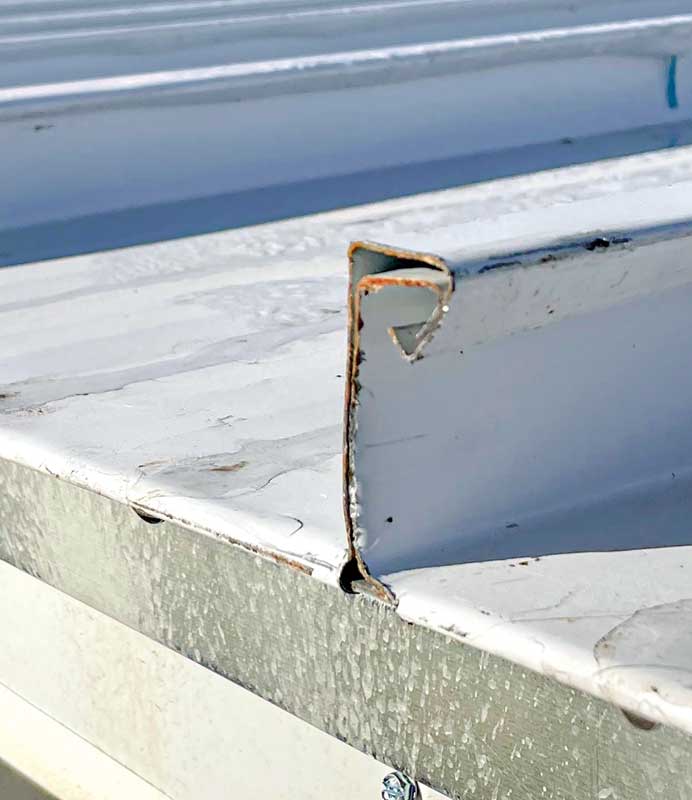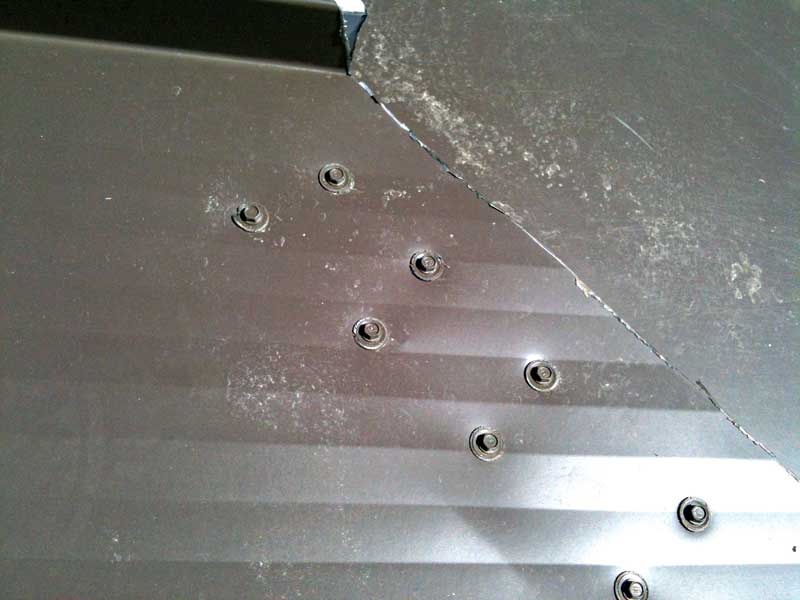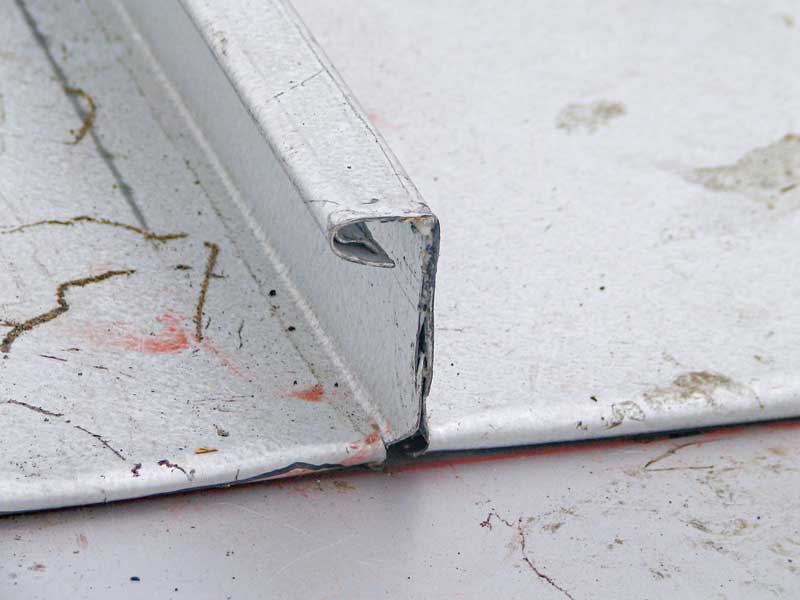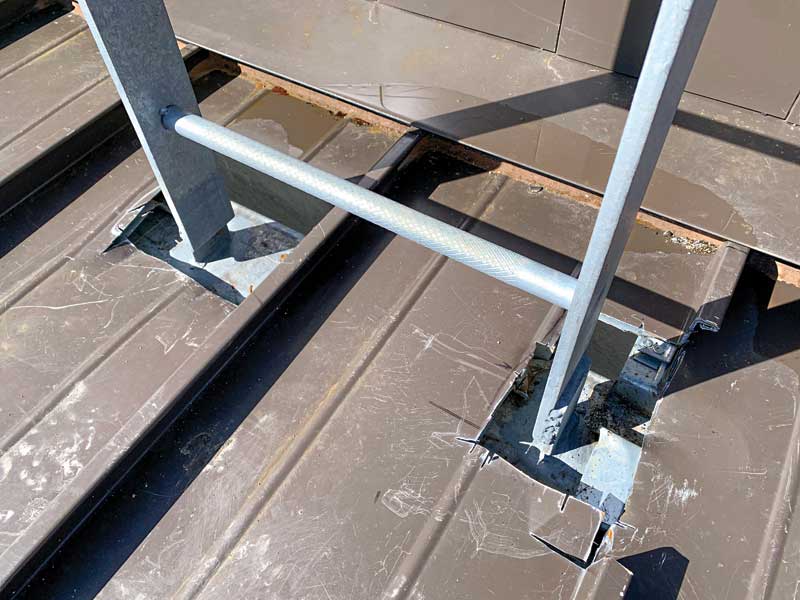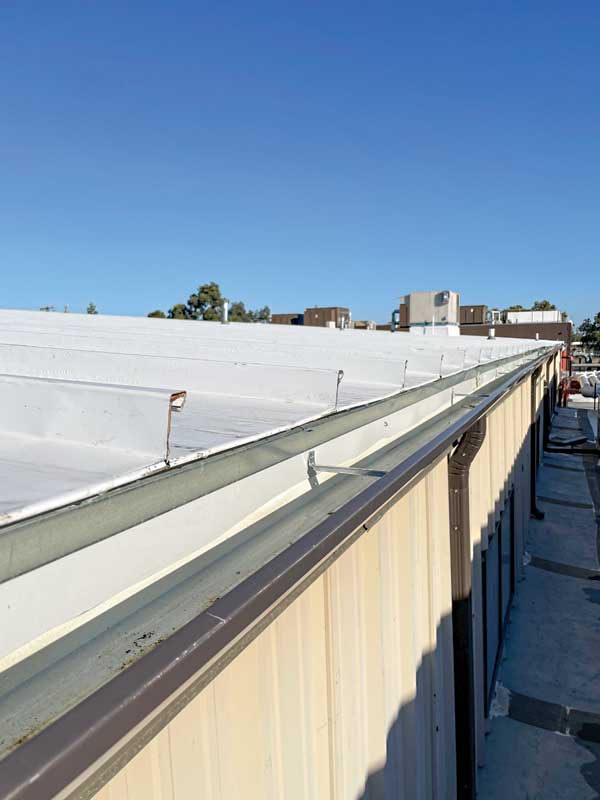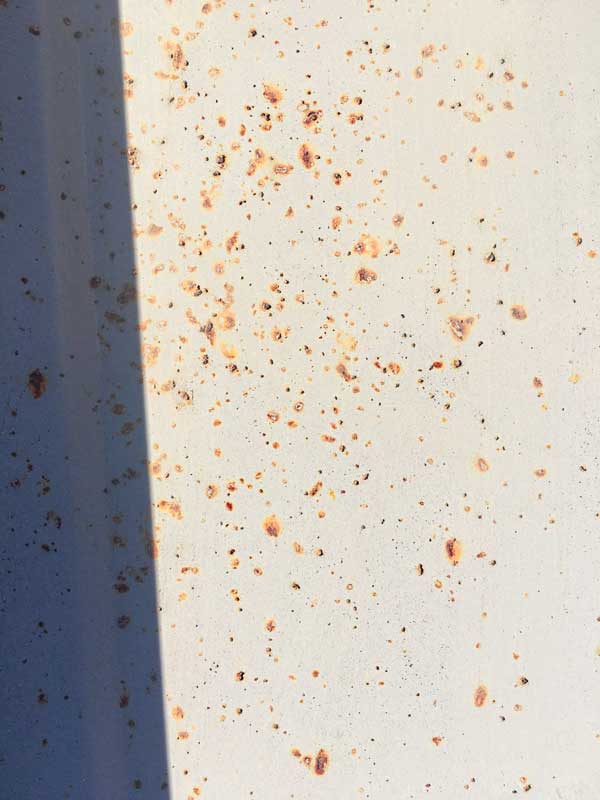Out in the Field
by marika_gabriel | 25 November 2023 1:00 pm
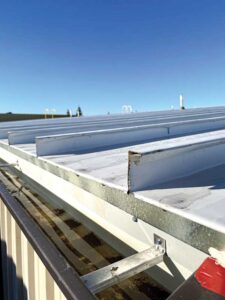 [1]
[1]There are many unavoidable conditions when installing metal roofing assemblies. Cut edges are no exception. Factory cuts are those made to the panels and flashings during factory fabrication of the material. However, factory cuts may not work or be practical for certain transitions or roof conditions such as hips, valleys, roof penetrations, or any other myriad conditions that can exist on a roof. In these instances, certain conditions may require the installer to perform field-cuts. The most common roof instances include the need to miter-cut a panel end at a valley or hip, at an eave that is not perpendicular to the slope, and at penetrations. Another example is panels that require lengths shorter than can be produced on rollforming mills.
When performing field-cuts, cut edge corrosion is of serious concern. Field cutting edges must follow manufacturer recommendations and use proper tools to minimize the possibility of edge corrosion. Improperly cutting material can leave the raw exposed edges susceptible to unsightly workmanship or, worse, corrosion at the cut edge of material. Improperly cut panels can create corrosion and finish deficiencies that will compromise material and paint finish warranties if this cut edge is exposed to weather.
Cutting issues
Light gauge painted products are all around. This highly versatile metal product is used for a range of construction products, including metal roofing, metal siding, insulated metal panels (IMPs), gutters, and downspouts. Gauge refers to the thickness of the metal; “light gauge” commonly refers to the relatively thin amount of metal in the product. This is due to the inherent strength of steel and aluminum, and the added strength created through forming. Thin, light gauge metal products suit a wide range of applications and provide a durable, strong, and economical solution. Prior to painting, light gauge steel products are encased in a metallic coating that is a combination of metals—either zinc (galvanized) or aluminum and zinc (Zincalume/Galvalume)—which provides a protective and sacrificial barrier from corrosion. This coating is applied as a molten liquid metal to the base steel to create a metallurgical bond between base steel and coating metal.
Product manufacturers that use pre-painted metal, such as those that manufacture roofing and siding panels, use specialized shears to cut the metal to specific customer needs or lengths. A shearing process, similar to the action of scissors, cuts the metal in a singular stroke in which two sharpened blades apply pressure on either side of the metal in one fast action. These shears are often specific to the shape of the product.
This contrasts to a sawing motion in which the teeth of a blade progressively chip away at the surface in a more imprecise fashion. Sawing actions can produce imperfections and pronounced burrs, which are a pathway for corrosion to start. These protrusions, burrs, and jagged edges can place the carbon steel further away from the metallic coating, preventing it from working as a preferential protection element.
Sawing or abrasive cutting actions can also exceed the melting temperature of the metallic coating and melt it away from the base steel, further contributing to the potential for edge corrosion. A final downside of abrasive cutting is it can produce “swarf,” the name for the fine residual metallic filings and pieces. Often these fragments are so small they are not visible and can be unintentionally left on the metal surface. If these tiny particles are left on a metal surface, they can corrode and cause rust stains, creating a permanent visual deformation to the metal product. Cut-edge protection is a very misunderstood aspect of Zincalume/Galvalume coated steel. The reason the edges are left raw is due to the zinc component of the Zincalume/Galvalume coating protecting the steel as the sacrificial layer and preventing the steel from corroding further into the material. Complete coating of steel sheet products is not practical, economical, or generally necessary. It is normal practice—and has been since zinc/aluminum-coated sheets have been produced—to have slit, sheared, drilled, or cut edges.
In service, galvanic action causes zinc compounds to automatically build up at any cut edges or scratches by an electrolytic reaction when water or moisture is present. This slows the rate at which the surrounding coating is consumed around damaged areas. This effect is sometimes referred to as the “self-healing” property of coatings containing Zincalume/Galvalume.
The self-healing properties of Zincalume/Galvalume steel is why it is recommended that material only be cut using a shearing action. By shearing the material as is done in the factory, the zinc and aluminum coating is essentially folded over the exposed raw edge of the base steel. Keep in mind, some edge rust, even on factory-cut edges, is normal—especially when installation takes place in wet climates.
In more severe environments, Zincalume/Galvalume can offer superior cut edge protection. Galvanized coatings are sacrificial in nature, which means the zinc coating will corrode preferentially to the carbon steel, but over time it will be consumed. By comparison, Zincalume/Galvalume includes both zinc and aluminum. The zinc will corrode preferentially, but aluminum adds the benefit of a protective barrier, which means it slows the spread of corrosion and the rate at which this coating is consumed.
In some extreme environments, atmospheric conditions may be more severe in which additional steps can be taken to ensure cut edges are further shielded from the elements. Panel edges can be “hemmed,” whereby the exposed edge is folded and tucked underneath so the edge is not as exposed to environmental elements. Hemming is an action that bends and folds the edge of the metal back upon itself, concealing the edge. Flashing and trim pieces are often hemmed by the product manufacturer.
In some applications and environments, the thin exposed edge may show signs of surface oxidization. This is not cause for concern, as the metallic coating is usually working effectively, and the corrosion is not spreading—but this may be an undesirable visual effect.
Corrosion… or not
Are cut and exposed edges a source of corrosion? The short answer is no. However, as with all applications, it depends on installation and environmental factors. In general, there are several reasons that underpin why exposed edges are not a source of corrosion, including
the following:
- The edges of the strip of the material (edges of the coil) are uniformly cleaned and treated in the production process, which ensures no imperfections or dirt is trapped at the edges. It is these impurities and imperfections that often act as the catalyst in the corrosion process.
- As the carbon steel is so thin and encased by a metallic coating on both sides of the strip, the sacrificial properties of the coating can still work, diverting oxidization to the consumption and protection of the metallic coating. This works in the same way the metallic coating’s sacrificial properties will help prevent corrosion in the event the coated surface is scratched.
- Over time, the metallic coating will encase this cut edge. When rainwater washes down the cut edge, ions from the exposed metallic coating are deposited on the bare carbon steel edge. Over time, this builds up and further protects that edge.
Cutting tools
Several methods are used to cut metal panels.
Hand tools
- Sheet metal shears: A heavy-duty, long-handled pair of metal cutting scissors with short blades.
- Aviation snips: Left-hand cuts, green handles; right-hand cuts, red handles; straight cuts, yellow handles.
- Guillotine-style shearing blades: The most popular is a portable hinged device. It is commonly used to field cut corrugated or trapezoidal ribbed panels at right angles to the ribs. There is also a portable field table that will notch-out standing seam panel ribs, and another adjustable table that slits the flat up to a 45-degree angle.
Electric power tools
- Nibblers: A handheld oscillating punch-and-die that removes consecutive “moon-shaped” pieces, progressing forward to make the cut. When using this tool, it is difficult to cut in a straight line, especially up and over standing seam or trapezoidal ribs.
- Power shears: Electrical scissors that cut a straight strip of material out of the panel approximately 3.17-mm (0.125-in.) wide and curls up the strip in a “pigtail-type” configuration. This is a good tool to cut parallel to ribs, but difficult to cut across a panel. It is also a good tool for cutting the flat pan of a standing seam panel and for cutting a panel parallel to ribs.
- Circular saw blades: Though not recommended, examples of these blades are found in lumber yards, hardware stores, and home improvement stores.
- Abrasive metal cutting blades: In a circular saw, this blade produces extreme noise levels and high velocity spark steams, and leaves a ragged edge similar to a serrated knife blade. A panel cut with this blade requires a scissors-type hand tool to trim back the cut edge 12.7 mm (0.5 in.) if the panel end is to be left exposed to weather.
- Carbide-tipped wood/laminate blade or reversed combination blade: This blade is often used just for convenience. It also produces extreme noise, heat, and a ragged edge (as above). Carbide-tipped “metal” saw blades have been introduced into the industry that are used on portable saws to cut steel. These seven 6.35-mm (0.25-in.) circular blades are available with 48 or 70 teeth per blade. The 48-tooth blade will cut up to 3.17-mm (0.125-in.) thick steel, while the 70-tooth blade is recommended for “thin sheet metal.” Either blade will cut prefinished metal panels with very little “burring” on the cut edge. Provided the operator progresses the cut briskly to avoid friction, this blade does not produce hot sparks that are present when using an abrasive blade, wood/laminate blade, or a carbide-tipped wood blade. When a spark steam is produced while cutting, the edges of the cut are being heated beyond 199 C (390 F), destroying both the Zincalume/Galvalume corrosion coating and the pigmented color finish.
Proper use of carbide-tipped “metal” cutting blades includes the following:
- A worm drive electrical saw should be used to ensure a more consistent supply of torque than that of a direct drive electrical saw. The spin rate should be no more than 2,500 rpm.
- To avoid heat buildup caused by friction, the blade should be set to maximum depth, regardless of the rib height of the panel being cut. This allows the blade to cool on the return portion of the revolution.
- Cuts should be made by placing the base of the saw on the back side of the panel (i.e. cut the panel upside down). This allows the maximum depth of the spinning blade to cool.
Tool quality is something that should never be overlooked. Cutting sharpness, ease of use, and the overall quality of a tool are just as important as the procedures used to make final cuts to prefinished steel. Tool quality can greatly impact the difficulty in performing cuts or the finished look of the cuts themselves. This can impact the overall fit and finish of a metal roof or siding application. As the saying goes, “A good craftsman never blames their tools.” They most certainly can blame their tools if poor-quality tools are used to perform precise field-cuts or unrecommended cutting procedures are used in favor of speed over quality.
As with any rework that is required for a given product that may include a manufacturer’s warranty, it is highly recommended to consult the specific manufacturer to advise on what their requirements may be. This will better help to determine the best course of action to perform field cutting procedures and the recommended tools needed to properly field cut prefinished metal.
Jeff Haddock is technical services manager at AEP Span and ASC Building Products. He has 22 years of industry experience, all of which serving various roles from production to sales/customer service with AEP Span. Haddock has worked as the company’s lead weathertightness warranty program inspector for the past 16 years and has managed the department for the last four years.
- [Image]: https://www.metalconstructionnews.com/wp-content/uploads/2024/01/Saw-cut-panel-edge.jpg
Source URL: https://www.metalconstructionnews.com/articles/features/out-in-the-field/
